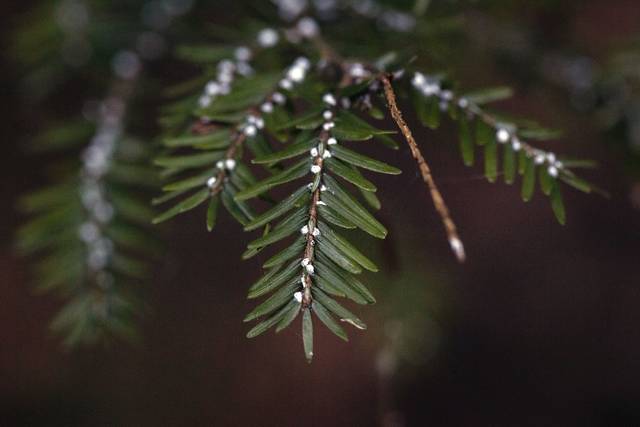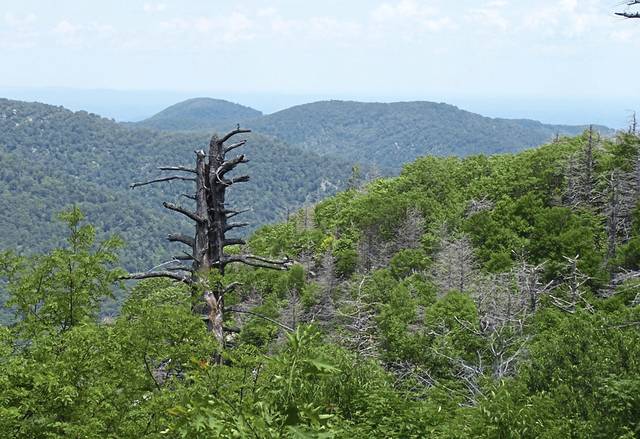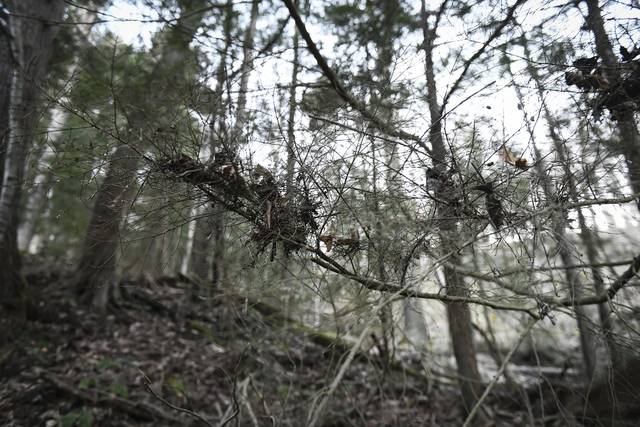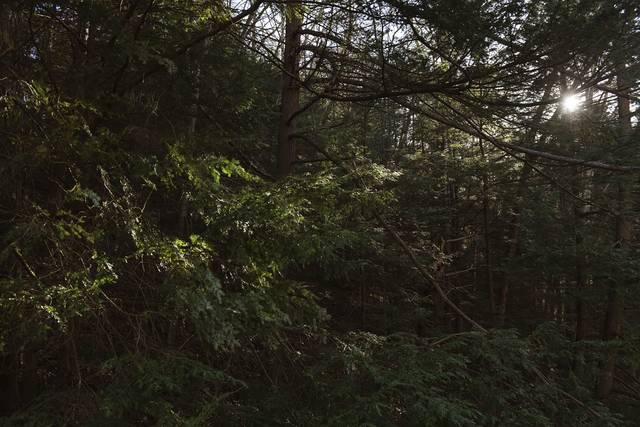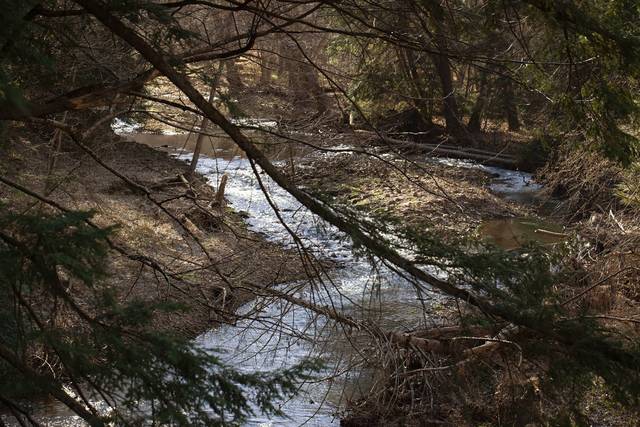Destructive insects threaten to attack, kill Eastern hemlocks in Western Pa.
A nasty tiny insect is sucking the life out the state tree, the Eastern hemlock, hitting iconic trees at the Flight 93 crash site, Cook Forest, Fallingwater and one of the wildest landscapes close to Pittsburgh — the Buffalo Valley watershed in Buffalo Township.
Known as the woolly adelgid, this invasive bug from Asia is about the size of a pepper grain. But its egg sacs are easily visible, looking like tiny tufts of cotton lining the undersides of hemlock branches.
If untreated, many hemlocks in the region face a death sentence in the next three to 10 years, said Timothy Tomon, a specialist for the Pennsylvania Department of Conservation and Natural Resources who focuses on the woolly adelgid.
It was first identified in Pennsylvania in 1973 and in Westmoreland County in 2006.
The adelgid population has exploded in the region in the past year, particularly in Butler and Allegheny counties, according to the department.
Over the past two decades, the invasive insect had been detected in all but three counties (Crawford, Mercer and Greene).
“Eventually, we will have to prioritize what is treated,” Tomon said. “We’re trying to concentrate on the parks and forests known for their hemlocks.”
The first ones to go
The first casualties will be the older trees and trees growing on rocks — both are more stressed and won’t be able to tolerate the attack, Tomon said.
Standing next to a bank of hemlocks impossibly perched on the rock cliffs in a deep river valley in Buffalo Township, resident Charles Bier pointed and said, “These will probably go.”
Bier, senior director of conservation science for the Western Pennsylvania Conservancy, discovered the woolly adelgid on his property several years ago, near Todd Nature Reserve and the Butler-Freeport Community Trail.
“I’m alarmed, and I have been waiting for it,” said Bier, who saw the devastation in the eastern and central part of the state for the past 20 years.
Almost all native evergreen trees in Southwestern Pennsylvania are Eastern hemlocks, he noted. The trees are distinctive and appreciated especially in winter, providing the only greenery in an otherwise brown, withered landscape.
“This has big implications for Pennsylvanians who have a sense of place for the native landscape,” Bier said.
It’s a poetic injustice in Buffalo Township, where areas are preserved by the Audubon Society of Western Pennsylvania because of the unique habitat provided by hemlocks.
Audubon, with help from the state Department of Conservation and Natural Resources, is treating different hemlocks in Buffalo Township.
But some won’t be helped and likely will die, Bier said. The adelgid is visible on nearby hemlocks along the Buffalo-Freeport trail.
Considering the loss of many stands of native hemlocks, Bier said, “This will be a slow burn.”
How bad is it?
The implications are bad, experts say.
“The trees on tops of the rocks that everyone wants to see at McConnells Mill state park will be gone in four years,” Tomon said.
State officials are trying to lessen the damage.
“We’re seeing the woolly adelgid everywhere,” Tomon said. The Penn State Cooperative Extension in Allegheny County reports it has been deluged with phone calls this year from residents who have the woolly adelgid on their hemlocks and want to save their trees.
There is no way to eradicate the woolly adelgid.
“All we can do is try to manage the trees and suppress the adelgid numbers so the trees can survive,” Tomon said.
In terms of number of trees lost, the threat of the adelgid is not as devastating as the American chestnut blight or Dutch elm disease in the state, he said. However, once you kill the hemlocks, so go other lifeforms.
The hemlock is more than a tree.
It’s a keystone species that plays a unique and important role in creating wildlife habitat, said Donald Eggen, forest health manager for the Pennsylvania Department of Conservation and Natural Resources.
“If you lose the hemlocks, you lose the fish, birds, insects, fungi, microbes, plants and some mammals associated with that hemlock habitat — which is a combination of shade, soil and water chemistry,” Eggen said.
Hemlock-lined ravines, known for their shade and cool waters, create habitat for native trout.
Only treatment, no cure
The main treatment for forest and iconic hemlock sites is an insecticide injected in the ground around the trees, a tedious process that cannot realistically work for large stands of trees, especially ones on inaccessible steep hills.
The best hope is the release of beetles and insects that eat the adelgid. But it takes years for their populations to grow large enough to eat enough adelgid to keep them at bay. The beetles are carefully selected predators that are specific to only the adelgid and will not go elsewhere in the environment, experts noted.
In the region, aggressive treatment programs are underway at the Western Pennsylvania Conservancy’s Fallingwater historical site and Bear Run Nature Reserve in the Laurel Highlands.
The Department of Conservation and Natural Resources is treating woolly adelgid infested hemlocks in McConnell Mills, Erie Bluffs, Cook Forest, Ohiopyle and other parks and state forests. Locally, the department has released predatory beetles to eat the adelgid in Sewickley Heights Borough Park and Fall Run park in Shaler.
The National Park Service just entered a new contract to continue its adelgid control program for the witness trees, a stand of hemlocks that Flight 93 hit as it crashed into a field in Shanksville during the 9/11 attacks.
Flight 93 National Memorial started a program to suppress the adelgid in 2013. During the next three years, workers will treat mature trees as well as seedlings and saplings across the 11-acre hemlock grove at the crash site, the National Park Service said.
The hemlock witness trees will be treated by a combination of soil injection, basal treatment, trunk injection, horticultural oil application and the introduction of predator beetles, said Katherine Hostetler, spokeswoman for the Flight 93 memorial.
“Although the adelgid will forever alter the hemlock grove at Flight 93 National Memorial, with continued funding, dedicated staff and committed partners, the hemlock witness trees will remain for future generations to learn what happened here on Sept. 11, 2001,” she said.
There is reason for hope. The beetles, along with experiments with other predatory insects, might become more effective in years to come, Tomon said. And some cold winters can whack the adelgid population, slowing them down, he added.
Pennsylvania has the resources and staff to fight, he said.
“We’ve got a big staff and more money than other states have; we’ve been connected with forest groups working on the same issues,” Tomon said.
Bier is hopeful. Hemlocks that are genetically resilient to the adelgid are out there. Treating hemlocks with beetles and insects likely will make a difference, even if it takes years.
“The conservancy jumped on this early on,” Bier said.
The nonprofit used insecticides on the trees around the historic Fallingwater house and nearby landscape. They established “insectories” for the beetle population to grow to eat the adelgid at Bear Run and Wolf Creek Narrows near Slippery Rock.
“We have tried to save some of the trees in the Bear Run watershed, but there are thousands and thousands of hemlocks on that property — some 5,000 acres,” he said. “You can’t really treat every tree.”
For people who have discovered woolly adelgid on their native Eastern hemlocks, check out this story for information on tips on what you can do next.
Remove the ads from your TribLIVE reading experience but still support the journalists who create the content with TribLIVE Ad-Free.


